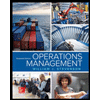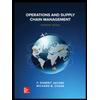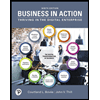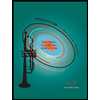Consider two different workstations. Each workstation consists of machines A and B, respectively. Machine A has a mean effective process time of 1.0 hours and an c² of 0.25. Machine B has a mean effective process time of 0.85 hour and an c² of 4. Assume the part arrival and service processes follow a general distribution. 1 (a) For an arrival rate of 0.92 job per hour with c2 = 1, which machine will have a shorter average cycle time? (b) Now put one more machine of type A at the station and double the arrival rate (i.e., double the capacity and the throughput). What happens to cycle time?
Consider two different workstations. Each workstation consists of machines A and B, respectively. Machine A has a mean effective process time of 1.0 hours and an c² of 0.25. Machine B has a mean effective process time of 0.85 hour and an c² of 4. Assume the part arrival and service processes follow a general distribution. 1 (a) For an arrival rate of 0.92 job per hour with c2 = 1, which machine will have a shorter average cycle time? (b) Now put one more machine of type A at the station and double the arrival rate (i.e., double the capacity and the throughput). What happens to cycle time?
Practical Management Science
6th Edition
ISBN:9781337406659
Author:WINSTON, Wayne L.
Publisher:WINSTON, Wayne L.
Chapter2: Introduction To Spreadsheet Modeling
Section: Chapter Questions
Problem 20P: Julie James is opening a lemonade stand. She believes the fixed cost per week of running the stand...
Related questions
Question

Transcribed Image Text:Consider two different workstations. Each workstation consists of machines A and B,
respectively. Machine A has a mean effective process time of 1.0 hours and an c² of 0.25.
Machine B has a mean effective process time of 0.85 hour and an c² of 4. Assume the part
arrival and service processes follow a general distribution.
1
(a) For an arrival rate of 0.92 job per hour with c2 = 1, which machine will have a shorter
average cycle time?
(b) Now put one more machine of type A at the station and double the arrival rate (i.e.,
double the capacity and the throughput). What happens to cycle time?
Expert Solution
This question has been solved!
Explore an expertly crafted, step-by-step solution for a thorough understanding of key concepts.
This is a popular solution!
Trending now
This is a popular solution!
Step by step
Solved in 4 steps with 5 images

Recommended textbooks for you

Practical Management Science
Operations Management
ISBN:
9781337406659
Author:
WINSTON, Wayne L.
Publisher:
Cengage,

Operations Management
Operations Management
ISBN:
9781259667473
Author:
William J Stevenson
Publisher:
McGraw-Hill Education

Operations and Supply Chain Management (Mcgraw-hi…
Operations Management
ISBN:
9781259666100
Author:
F. Robert Jacobs, Richard B Chase
Publisher:
McGraw-Hill Education

Practical Management Science
Operations Management
ISBN:
9781337406659
Author:
WINSTON, Wayne L.
Publisher:
Cengage,

Operations Management
Operations Management
ISBN:
9781259667473
Author:
William J Stevenson
Publisher:
McGraw-Hill Education

Operations and Supply Chain Management (Mcgraw-hi…
Operations Management
ISBN:
9781259666100
Author:
F. Robert Jacobs, Richard B Chase
Publisher:
McGraw-Hill Education


Purchasing and Supply Chain Management
Operations Management
ISBN:
9781285869681
Author:
Robert M. Monczka, Robert B. Handfield, Larry C. Giunipero, James L. Patterson
Publisher:
Cengage Learning

Production and Operations Analysis, Seventh Editi…
Operations Management
ISBN:
9781478623069
Author:
Steven Nahmias, Tava Lennon Olsen
Publisher:
Waveland Press, Inc.